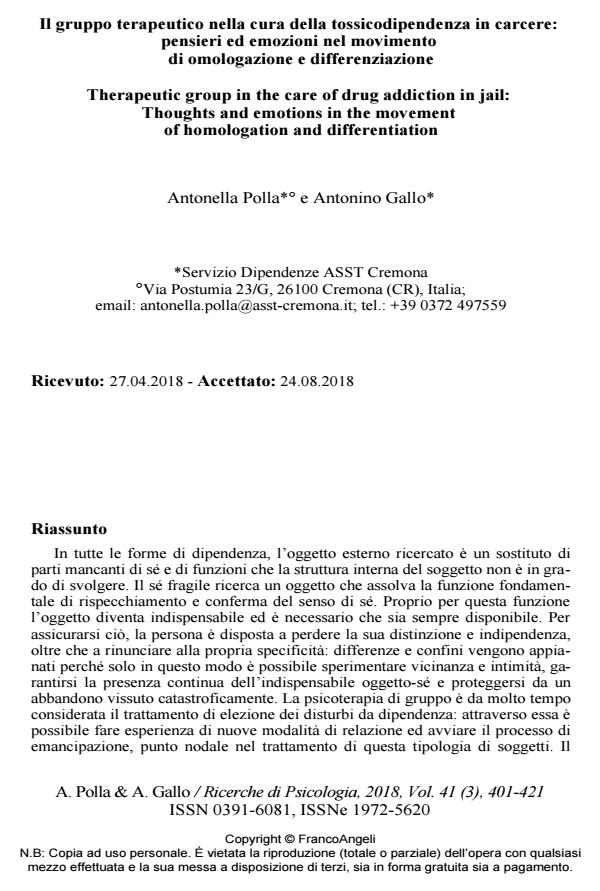Therapeutic group in the care of drug addiction in jail: Thoughts and emotions in the movement of homologation and differentiation
Journal title RICERCHE DI PSICOLOGIA
Author/s Antonella Polla, Antonino Gallo
Publishing Year 2018 Issue 2018/3
Language Italian Pages 21 P. 401-421 File size 69 KB
DOI 10.3280/RIP2018-003006
DOI is like a bar code for intellectual property: to have more infomation
click here
Below, you can see the article first page
If you want to buy this article in PDF format, you can do it, following the instructions to buy download credits

FrancoAngeli is member of Publishers International Linking Association, Inc (PILA), a not-for-profit association which run the CrossRef service enabling links to and from online scholarly content.
In all form of addiction the external object sought is a substitute for lacking parts of self and functions that the internal structure of the subject is unable to perform. The fragile self seeks an object that fulfills the fundamental function of mirroring and confirmation of self-consciousness the sense of self. Precisely for this function the object becomes indispensable and it is necessary that it is always available. To ensure this, the person is willing to lose his differentiation and independence, as well as to renounce his specificity: differences and boundaries are smoothed because only in this way is it possible to experience closeness and intimacy, guaranteeing the continuous presence of the indispensable object- self and protect himself from a catastrophically neglected abandonment. Group psychotherapy has long been considered the treatment of choice for addictive disorders: through it is possible to experience new modes of relationship and start the process of emancipation, a nodal point in the treatment of this type of subjects. The homogeneous group is able to provide support to patients so fragile from the narcissistic point of view and makes it possible to compare with others that can be experienced as a resource and not perceived in terms of individual defeat and self-denial. The relationship with the other can thus be constituted as an exchange based on mutual recognition, thus breaking the typical isolation of addiction or, alternatively, the exclusive method of homologation. The clinical vignettes taken from the group psychotherapy work within Cremona jail are aimed to underline a continuous process, which unfolds along the whole group path, characterized by an oscillation between homologation and differentiation, and to show how this own process can start the possibility of emancipation.
Keywords: Group psychotherapy, addiction, homologation and differentiation, Field Theory.
Antonella Polla, Antonino Gallo, Il gruppo terapeutico nella cura della tossicodipendenza in carcere: pensieri ed emozioni nel movimento di omologazione e differenziazione in "RICERCHE DI PSICOLOGIA " 3/2018, pp 401-421, DOI: 10.3280/RIP2018-003006